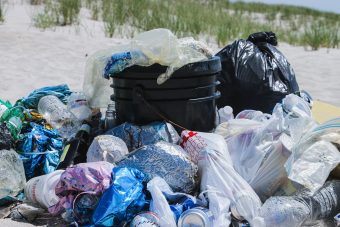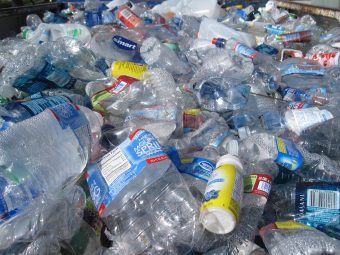
Rivals – traditionally – tend not to work together. This approach can help companies stay distinct as one-of-a-kind innovators and maintain competitive advantages. It can even protect consumers’ interests. Legislation exists across the world to prevent cartels that could force consumers to pay more for certain products than they would otherwise.
But when it comes to problems such as plastic waste, rivals will need to learn to solve problems in new ways. The urgent need for system-wide changes to benefit the environment could spark lasting changes to how rivals work together for both planet and profits.
A long-held problem
According to the UNEP, the world produces more than 300 million tonnes of plastic waste a year – more than the weight of the world’s population. Still, according to some estimates, only around 6 percent of plastic is recycled globally.
To be sure, not every locale recycles plastics at high rates and some plastic packaging cannot be reused at all once it reaches its ‘end-of-life’ stage’. Still more plastic isn’t recycled because of the breathtaking variety of plastic packaging that is produced. Almost no two pieces of packaging are exactly the same. This variety of material, colour, shape and design creates two key problems. On the consumer side, consumers simply do not understand what can be recycled in their locality. On the sorting and recycling side, it is difficult to sort the variety of packaging into the appropriate fractions for recycling, making sorting more difficult and expensive, and driving down the volume of plastic packaging which can be recycled, and with it, recycling rates.
In Europe, this means that only between roughly 20 percent-40 percent of all plastic waste is recycled. Often, ‘downcycling’ or ‘open loop recycling’ is in place, where the materials from the packaging are recycled into use in more basic applications (e.g. food-contact packaging becomes plant pots).
Standardization at the product design stage could transform recycling rates for the better. Easily recyclable packaging could be prioritized and consumers could more easily sort this appropriately. Once collected, this waste could be more easily and cheaply sorted by facilities. Higher levels of waste would make it through to the recycling stage and less would be lost to landfill, incineration or export (as is currently the case). Through standardization, new recycling economies of scale could be developed, facilitating large increases in recycling rates.
More:
With more standardized packaging increasing recycling rates, it could be possible to create a more reliable supply of Post-consumer-recyclate (PCR) output, therefore increasing supply (and quality) of PCR. This is good news for brands. Firstly, many have set targets to include a certain amount of recycled plastic in their packaging. At the moment, supply of high-quality recyclate is low, meaning brands are struggling to source the amounts they require and continue to rely heavily on virgin resin. Secondly, by increasing the levels of recyclate in their packaging, brands increase their resilience. With PCR available locally, they reduce their exposure to the volatilities of international commodity markets. (While the price of oil remains low today, this could change as exploration slows and carbon taxes kick in. As a result, the ability to purchase oil-based products cheaply should not be taken as a given.)
A new solution
Rivals could improve these rates, by working together and standardizing the types of packaging they use. While governments have a role to play through Extended Producer Responsibility (EPR) systems, brand owners understand both end-consumers and the associated packaging requirements much better and have traditionally also been able to move much more quickly than governments.
Still, these efforts face many barriers. Among them are entrenched ideas, from the need for unique packaging to attract consumers to the idea that working together with rivals should simply not be an option.

Education also plays a role. Brands must accept that the days of unlimited flexibility when it comes to designing packaging are over. Consumers need to understand the value of standardized packaging and stop rewarding brands who use bespoke packaging solutions which do not contribute to recycling rates. And governments need to work closely with brands to ensure EPR systems make sense (e.g. rewarding packaging which can be easily recycled on a local level).
Antitrust issues, however, are likely the largest hurdles to clear. Standardization of the sort described in this article requires a number of players from across the value chain working together and agreeing on packaging specifications, materials and even suppliers. Currently, antitrust rules limit the amount of information which competitors can share with one another, sometimes hindering efforts to commercialize sustainable solutions. As Amelia Miazad, an expert in sustainable capitalism at Berkeley Law, put it in a recent academic piece: ‘Coordinating with competitors to offer a more sustainably packaged product is a per se antitrust violation’.
As antitrust fines can be high, and most executives are not always fluent in the language of antitrust regulation, this level of collaboration is often avoided.
Looking ahead
Help is on hand, in Europe at least. The EU Commission has announced that it is examining how it can tweak antitrust legislation to support the newly announced EU Green Deal. As ‘simplifying packaging’ is one of its key aims in the plastics value chain, finding ways for rivals to work together is crucial to achieving this. Hopefully sensible solutions can be found which safeguard consumers whilst also safeguarding the planet.
Leaders are also learning the value of pre-competitive conversations with rivals. Industry bodies such as the Alliance to End Plastic Waste and the New Plastics Economy from the Ellen Macarthur Foundation both offer the chance for brands to work together on exchanging ideas.
The World Economic Forum, through its Global Plastic Action Partnership, also works closely with governments, businesses and civil society to translate commitments into meaningful action at both the global and national levels.
These efforts will also be helped by changing markets. Consumers have become increasingly climate-conscious and understand more and more that standardized packaging is key to tackling plastic waste. With this shift, the business case for non-standardized packaging will diminish and standardized plastic packaging will become a way to signal a commitment to sustainability and build brand equity.
Tackling the massive sustainability issues the planet faces requires urgent system-wide action. But it also requires a new approach to innovation. In a more climate-positive future, innovation won’t rest on a single mind or invention, it will come from the solutions that diverse groups of people create. Rivals working together won’t just reshape their industries – they’ll change how we understand problem solving and the nature of innovation.
Source: World Economic Forum



